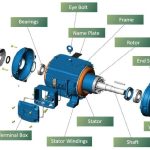What’s Inside a Vacuum Motor?

The Basic Parts
- Copper wires wrapped in coils (like a spring)
- A magnetic core (like a really strong magnet)
- Protective covering to keep the wires safe
- Connection points where power goes in
How It Works
- Electricity flows through the copper coils
- This creates a magnetic field (like invisible force fields)
- The magnetic field makes parts of the motor spin
- The spinning creates the power to suck air
How Does It Connect to the Vacuum?
The Connection Points
- Special seals to keep air from leaking
- Materials that work well in vacuums
- Ways to keep the motor cool
- Shock absorbers to stop shaking
What It Needs to Work Well
- Right amount of suction power
- Proper air flow
- Correct electrical power
- Good operating conditions
Taking Care of Your Motor
Regular Checks
- Daily Lookover
- Check for unusual noises
- Feel for strange vibrations
- Make sure it’s not too hot
- Listen for weird sounds
- Weekly Tasks
- Clean the outside
- Check all connections
- Look for loose parts
- Test the suction
- Monthly Jobs
- Deeper cleaning
- Check all parts
- Test performance
- Update maintenance records
Common Problems and Fixes
- Electrical Issues
- Burned-out wires
- Short circuits
- Loose connections
- Bad insulation
- Moving Parts Problems
- Worn-out bearings
- Parts not lined up right
- Too much shaking
- Cooling system not working
- Vacuum Problems
- Air leaks
- Bad seals
- Loss of suction
- Blocked air flow
Smart Features and Future Improvements
Modern Features
- Smart Controls
- Can turn on/off automatically
- Changes speed as needed
- Warns if something’s wrong
- Can be controlled from far away
- Safety Features
- Stops if it gets too hot
- Prevents overload
- Emergency stop button
- Problem detection
What’s Coming in the Future
- New Technology
- Better materials
- Internet connection
- AI control systems
- Better monitoring
- Improvements
- Uses less energy
- More reliable
- Easier to maintain
- Better performance
Remember These Important Points:
- Choose the right motor for your needs
- Check it regularly
- Keep track of how it’s working
- Fix problems quickly
- Focus on safety
- Save energy when possible
- Stay up to date with new features








